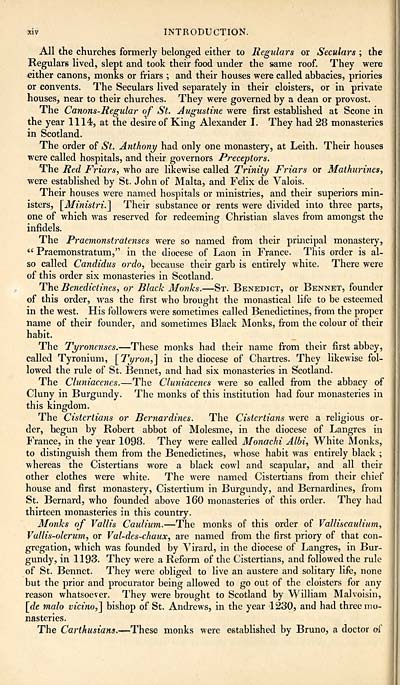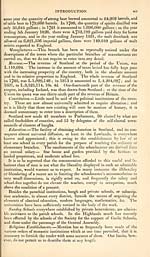Gazetteer of Scotland > Volume 1
(22) Page xiv
Download files
Complete book:
Individual page:
Thumbnail gallery: Grid view | List view

xiv INTRODUCTION.
All the churches formerly belonged either to Regulars or Seculars ; the
Regulars lived, slept and took their food under the same roof. They were
either canons, monks or friars ; and their houses were called abbacies, priories
or convents. The Seculars lived separately in their cloisters, or in private
houses, near to their churches. They were governed by a dean or provost.
The Canons-Regular of St. Augustine were first established at Scone in
the year 1114, at the desire of King Alexander I. They had 28 monasteries
in Scotland.
The order of St. Anthony had only one monastery, at Leith. Their houses
were called hospitals, and their governors Preceptors.
The Red Friars, who are likewise called Trinity Friars or Mathurines,
were established by St. John of Malta, and Felix de Valois.
Their houses were named hospitals or ministries, and their superiors min-
isters, [Ministri.] Their substance or rents were divided into three parts,
one of which was reserved for redeeming Christian slaves from amongst the
infidels.
The Praemonstratenses were so named from their principal monastery,
" Praemonstratum," in the diocese of Laon in France. This order is al-
so called Candidus ordo, because their garb is entirely white. There were
of this order six monasteries in Scotland.
The Benedictines, or Black Monks. — St. Benedict, or Bennet, founder
of this order, was the first who brought the monastical life to be esteemed
in the west. His followers were sometimes called Benedictines, from the proper
name of their founder, and sometimes Black Monks, from the colour of their
habit.
The Tyronenses. — These monks had their name from their first abbey,
called Tyronium, [Tyron,] in the diocese of Chartres. They likewise fol-
lowed the rule of St. Bennet, and had six monasteries in Scotland.
The Cluniacenes. — The Cluniacenes were so called from the abbacy of
Cluny in Burgundy. The monks of this institution had four monasteries in
this kingdom.
The Cistertians or Bernardines. The Cistertians were a religious or-
der, hegun by Robert abbot of Molesme, in the diocese of Langres in
France, in the year 1098. They were called Monachi Albi, White Monks,
to distinguish them from the Benedictines, whose habit was entirely black ;
whereas the Cistertians wore a black cowl and scapular, and all their
other clothes were white. The were named Cistertians from their chief
house and first monastery, Cistertium in Burgundy, and Bernardines, from
St. Bernard, who founded above 160 monasteries of this order. They had
thirteen monasteries in this country.
Monks of Vallis Caulium. — The monks of this order of Valliscaulium,
Vallis-olerum, or Val-des-chaux, are named from the first priory of that con-
gregation, which was founded by Virard, in the diocese of Langres, in Bur-
gundy, in 1 1 93. They were a Reform of the Cistertians, and followed the rule
of St. Bennet. They were obliged to live an austere and solitary life, none
but the prior and procurator being allowed to go out of the cloisters for any
reason whatsoever. They were brought to Scotland by William Malvoisin,
[de malo vicino,~\ bishop of St. Andrews, in the year 1230, and had three mo-
nasteries.
The Carthusians. — These monks were established by Bruno, a doctor of
All the churches formerly belonged either to Regulars or Seculars ; the
Regulars lived, slept and took their food under the same roof. They were
either canons, monks or friars ; and their houses were called abbacies, priories
or convents. The Seculars lived separately in their cloisters, or in private
houses, near to their churches. They were governed by a dean or provost.
The Canons-Regular of St. Augustine were first established at Scone in
the year 1114, at the desire of King Alexander I. They had 28 monasteries
in Scotland.
The order of St. Anthony had only one monastery, at Leith. Their houses
were called hospitals, and their governors Preceptors.
The Red Friars, who are likewise called Trinity Friars or Mathurines,
were established by St. John of Malta, and Felix de Valois.
Their houses were named hospitals or ministries, and their superiors min-
isters, [Ministri.] Their substance or rents were divided into three parts,
one of which was reserved for redeeming Christian slaves from amongst the
infidels.
The Praemonstratenses were so named from their principal monastery,
" Praemonstratum," in the diocese of Laon in France. This order is al-
so called Candidus ordo, because their garb is entirely white. There were
of this order six monasteries in Scotland.
The Benedictines, or Black Monks. — St. Benedict, or Bennet, founder
of this order, was the first who brought the monastical life to be esteemed
in the west. His followers were sometimes called Benedictines, from the proper
name of their founder, and sometimes Black Monks, from the colour of their
habit.
The Tyronenses. — These monks had their name from their first abbey,
called Tyronium, [Tyron,] in the diocese of Chartres. They likewise fol-
lowed the rule of St. Bennet, and had six monasteries in Scotland.
The Cluniacenes. — The Cluniacenes were so called from the abbacy of
Cluny in Burgundy. The monks of this institution had four monasteries in
this kingdom.
The Cistertians or Bernardines. The Cistertians were a religious or-
der, hegun by Robert abbot of Molesme, in the diocese of Langres in
France, in the year 1098. They were called Monachi Albi, White Monks,
to distinguish them from the Benedictines, whose habit was entirely black ;
whereas the Cistertians wore a black cowl and scapular, and all their
other clothes were white. The were named Cistertians from their chief
house and first monastery, Cistertium in Burgundy, and Bernardines, from
St. Bernard, who founded above 160 monasteries of this order. They had
thirteen monasteries in this country.
Monks of Vallis Caulium. — The monks of this order of Valliscaulium,
Vallis-olerum, or Val-des-chaux, are named from the first priory of that con-
gregation, which was founded by Virard, in the diocese of Langres, in Bur-
gundy, in 1 1 93. They were a Reform of the Cistertians, and followed the rule
of St. Bennet. They were obliged to live an austere and solitary life, none
but the prior and procurator being allowed to go out of the cloisters for any
reason whatsoever. They were brought to Scotland by William Malvoisin,
[de malo vicino,~\ bishop of St. Andrews, in the year 1230, and had three mo-
nasteries.
The Carthusians. — These monks were established by Bruno, a doctor of
Set display mode to: Large image | Transcription
Images and transcriptions on this page, including medium image downloads, may be used under the Creative Commons Attribution 4.0 International Licence unless otherwise stated. ![]()
| Gazetteers of Scotland, 1803-1901 > Gazetteer of Scotland > Volume 1 > (22) Page xiv |
|---|
| Permanent URL | https://digital.nls.uk/97424626 |
|---|
| Description | Volume I: Abbey to Glenartney. |
|---|---|
| Attribution and copyright: |
|
| Description | By Robert Chambers and William Chambers. Glasgow: Blackie & Son, 1838. 2 volumes. |
|---|---|
| Shelfmark | NF.1461.g.7 |
| Additional NLS resources: | |

